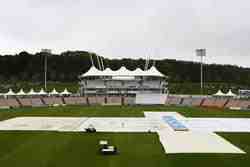
A gradual but inevitable descent into cricket-based loathing and bile.
Test Cricket vs. The Weather
England’s recently concluded series against Sri Lanka certainly wasn’t one of those destined to live long in the memory, a fate that often befalls the ‘early season’ Test series in the English summer. While Sri Lanka are far from a great Test side at the moment and England certainly deserved their victory, it’s fair to say that the real winner in this series was the weather. All three Tests were haunted by the regular sight of the players trudging off and the covers coming on.
While a number of sports suffer from weather-related delays, cricket is unique in that it is the only one that allows that weather to dictate the result. While tennis, golf or outdoor Kabaddi may have to stop until Mother Nature has finished making a scene, they will all return and then play to a result. For Test cricket, if it rains for five days then that’s tough.
This has been the case for many years now but with the cost of attending modern Test cricket continuing to rise, crowds are becoming less and less willing to accept the status quo. This reached a nadir in the recently completed match at The Rose Bowl, where the full-house crowd (after just a handful of overs on the third day) booed as the players took tea during a rare period of bright sunshine.
Here at 51allout we’re not afraid of change. We were firmly behind the legendary ‘Ian Salisbury Out’ campaign of 2000 and we have a few simple ideas on how to change things for the better.
The first idea is to introduce a spare sixth day at the end of every Test match, used to make up lost play from the first five days. The ICC can simply do away with the rule enforcing three clear days between back-to-back Tests, because it stands to reason that if we need a day six then we haven’t been playing for five days anyway.
Tickets for day five are very rarely sold in advance and day six need not be any different. An extra day of (appropriately priced) ticket sales would bring in extra revenue and lead to a greater proportion of results, thus better selling Test cricket as a contest.
The need for a sixth day touches on another recurring issue – the modern propensity for slow over rates. In T20 cricket you often see teams rushing to get their overs done in time, yet in Test cricket teams often give the impression that bowling 90 overs in a full day seems far too much like hard work. Teams currently aren’t penalised in any meaningful way by financial sanctions and the ICC’s decision to punish captains for two breaches in a year (rather than three) doesn’t go far enough. On this tour Sri Lanka have been downright slovenly and England no better. The time has come for penalty runs to be introduced – it’s hardly as if any of the bowlers have Joel Garner-esque run-ups.
Perhaps the most obvious solution would be to ditch the rigid approach to session times. Modern weather forecasting techniques mean that everyone knows when bad weather is coming. So why stop for tea during the sunny bits? Instead, at the start of play the captains and the umpires should agree on the best way to get 90 overs in for the day. Bad weather due in the afternoon? Ditch the tea interval and reduce lunch by ten minutes. There is bright sunshine at 7am in England during the peak summer months. There is very little reason why play couldn’t start at 10am if the previous day has seen a shortfall in the number of overs.
There’s also the question of breaks in play. Away from tropical or sub-continental conditions, is there really a need for drinks to be taken every hour? If rehydration is necessary, at least restrict them to natural gaps in play, i.e. the fall of wickets. Bottles can be kept on the boundary at fine-leg for fast bowlers to drink from as well.
In the Lord’s Test, there was a five minute delay when a physio came on to treat a player. If a player is hurt, e.g. from a blow on the finger or cramp, then he should leave the field of play for treatment. Get them off, bring on the sub or next batsman, and let the crowd watch the game that they’ve paid for.
It’s quite sad that these ideas are really simple. There’s nothing revolutionary here, just a little bit of common sense, which is perhaps why the ICC don’t seem remotely interested in considering the issues (whereas the continuous tinkering with ODI powerplay regulations demonstrate they have the time to address inconsequential problems). These changes may not make much difference and the country may be blessed by constant sunshine for the rest of the summer. But for the sake of the paying spectator, there is nothing to lose in experimenting with some or all of these ideas, which are far-less controversial than introducing day-night Tests and which may just help the crowd see more sporting action for their money.


No Comments
Post a Comment